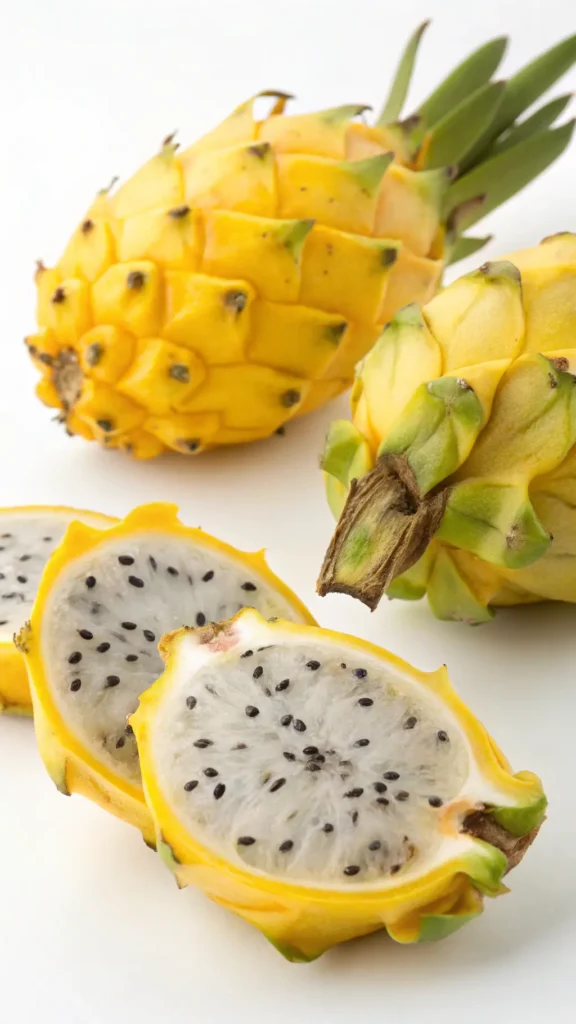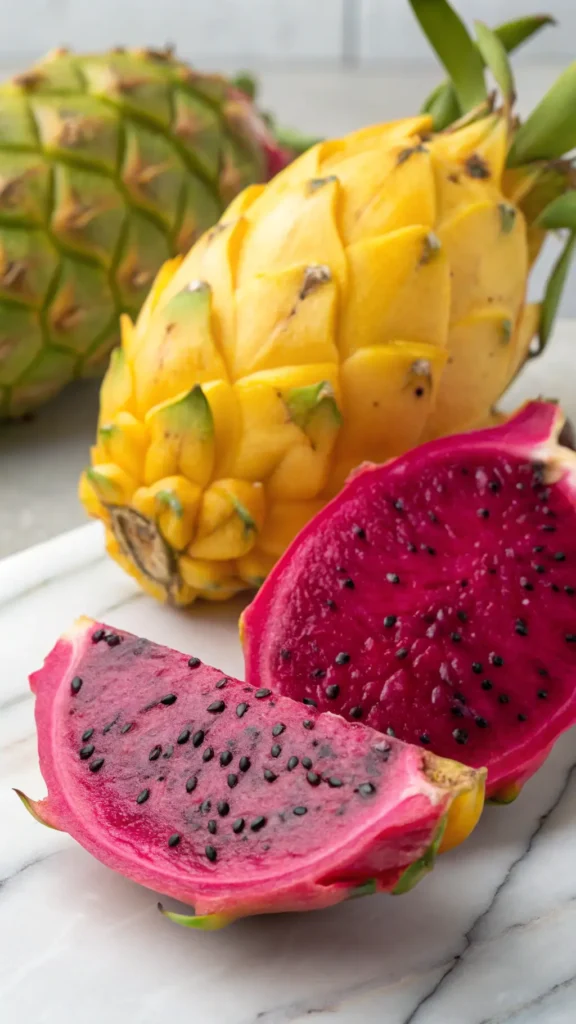When I first held a yellow dragon fruit in my hand, I didn’t know what to expect. Its vibrant, spiky skin looked like something out of a tropical dream. I had just left the farmers’ market, carrying a few fresh finds to brighten our weekly meals. That golden pitaya, with its sunny skin and promise of sweetness, became a new family favorite.
Pitaya yellow dragon fruit is more than just a pretty fruit. It’s rich in nutrients, delightfully sweet, and surprisingly simple to enjoy. Whether you’re focused on gut health, hydration, or just discovering new flavors, this tropical gem has a place in your kitchen and wellness routine.
Let’s dive into everything you need to know about pitaya yellow dragon fruit from how to eat it to why it might be one of the best things you add to your grocery list this year.
Table of Contents
How to Eat Pitaya yellow dragon fruit
Eating pitaya yellow dragon fruit is refreshingly simple and there are several ways to enjoy it depending on your taste and creativity.
1. Eat It Raw (My Favorite Way)
Just slice it in half and scoop out the white, seed-speckled flesh with a spoon. It has a naturally sweet, juicy flavor that makes it a satisfying snack all on its own.
2. Blend It Into Smoothies
Its creamy texture and sweet profile pair beautifully with banana, pineapple and mix it with this Ananas Banana Smoothie, or coconut water. I love tossing it into a post-workout smoothie to rehydrate and refuel.
3. Add to Fruit Bowls or Yogurt
Chopped yellow dragon fruit adds a pop of color and tropical taste to yogurt parfaits, acai bowls, or simple fruit salads.
4. Freeze for a Sorbet-Like Treat
Dice it up and freeze it for a naturally sweet, hydrating frozen treat.
Pro Tip: Always wash the skin thoroughly before slicing, even if you’re not eating it. And don’t eat the peel, the magic is all in the center.

Pitaya Yellow Dragon Fruit Benefits
Yellow dragon fruit (pitaya) isn’t just pretty on the outside. It offers a range of health benefits that can support your body and boost your mood.
- High in Antioxidants: Including vitamin C, betalains, and carotenoids that help fight free radicals.
- Supports Digestive Health: Thanks to its fiber-rich content and natural prebiotics that feed healthy gut bacteria.
- Hydration Hero: With high water content, it’s ideal for replenishing fluids, especially in summer.
- Heart Health: The fruit contains beneficial plant compounds that may support cholesterol balance.
- Immune Support: A good source of vitamin C and essential minerals like magnesium.
It’s a gentle, nourishing food that feels like a treat but works hard behind the scenes to support your wellness.
What Does Yellow Dragon Fruit Taste Like?
Here’s where yellow dragon fruit steals the show. While red and white dragon fruit can be a bit mild, yellow pitaya is the sweetest and most flavorful of them all.
Imagine a soft pear, a touch of kiwi, and the juiciness of a ripe melon, all wrapped into one. Its flesh is tender, speckled with tiny black seeds (completely edible), and surprisingly fragrant.
It’s nature’s dessert, perfect for anyone trying to reduce processed sugar while still enjoying something delightfully sweet.
What Are the Side Effects of Yellow Dragon Fruit?
Pitaya Yellow dragon fruit is generally considered safe for most people. However, like any food, there are a few things to keep in mind:
- Overeating Can Cause Digestive Discomfort: Due to its high fiber content, eating too much at once might lead to bloating or gas.
- Mild Allergies (Rare): Although uncommon, some individuals might have a sensitivity. Always introduce new fruits gradually.
- Urine Discoloration: Some people notice a harmless pink tinge in their urine after eating dragon fruit. It can be surprising but is not dangerous.
If you have concerns about your digestive system or food sensitivities, consult your healthcare provider before adding exotic fruits to your diet regularly.
When Is the Best Time to Eat Yellow Dragon Fruit?
You can enjoy Pitaya Yellow dragon fruit any time of day, but here are a few favorite ways I serve it:
- Morning Smoothies or Breakfast Bowls: To hydrate and energize.
- Midday Snack: Its natural sugar content provides a sweet pick-me-up without the crash.
- After Dinner Treat: Sliced and chilled, it makes a light and healthy dessert.
In terms of seasonality, yellow dragon fruit is often harvested in tropical regions during late summer and fall, but availability can vary depending on where you live.
Backed by Science: What Research Says About Yellow Pitaya
While traditional wisdom has long praised dragon fruit, modern science is starting to catch up. Here’s what studies and nutritionists say:
- A study published in the Journal of Pharmacognosy and Phytochemistry notes that pitaya is rich in antioxidants and may have anti-inflammatory effects.
- Nutritionists emphasize its fiber content for improving gut microbiome diversity.
- Research has also highlighted the presence of prebiotics, which help nurture the growth of good gut bacteria.
That means every bite is doing more than satisfying your taste buds, it’s nourishing your body at a cellular level.

Yellow Dragon Fruit and Weight Loss
If you’re on a journey toward better health or trying to manage your weight naturally, pitaya yellow dragon fruit can be a delicious and supportive ally.
Here’s why this golden fruit fits beautifully into weight-conscious lifestyles:
- Low in Calories: Despite its sweet flavor, yellow dragon fruit is relatively low in calories, making it a guilt-free snack.
- Rich in Fiber: Fiber keeps you full longer and helps regulate appetite and digestion, which can support weight management.
- Natural Sweetness: It satisfies sugar cravings without the need for processed sweets.
- Hydration Boost: Proper hydration is key to healthy metabolism and this fruit delivers.
Many women I talk to have found that incorporating yellow dragon fruit into their snacks or breakfast bowls helps them feel more satisfied while sticking to whole, nourishing foods.
Final Thoughts: Why This Fruit Stays in My Fridge
There’s something about yellow dragon fruit that feels like sunshine on a spoon. As a mom, I’m always looking for small ways to nourish my family and make healthy choices feel joyful, and pitaya yellow dragon fruit does just that.
If this golden fruit has inspired you to try something new or reconnect with simple nourishment, I’d love to hear about it. share it with someone you love. and make sure you Follow on Facebook.
FAQ about Pitaya yellow dragon fruit
Is yellow pitaya the same as yellow dragon fruit?
Yes, “yellow pitaya” and “yellow dragon fruit” refer to the same fruit. It comes from the Hylocereus megalanthus species and is known for its spiky yellow skin and sweet white flesh.
Are pitaya and dragon fruit the same?
Essentially, yes. “Pitaya” is the original name used in Latin America, while “dragon fruit” is the more common name in English-speaking countries. Both refer to fruits from the cactus family.
Why is yellow dragon fruit so expensive?
There are a few reasons:
– It’s more difficult to grow and harvest compared to the red or white varieties.
– It has a shorter shelf life, making it trickier to ship.
– The flavor is richer and sweeter, making it more sought after.
Can you eat yellow dragonfruit raw?
Absolutely! In fact, that’s the most popular way to enjoy it. Slice, scoop, and eat it fresh. It doesn’t require any cooking or preparation beyond a quick wash.




